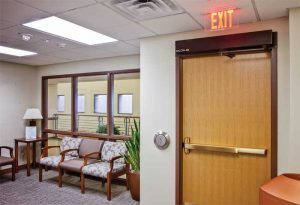
Electronic locks
An electronic lock is controlled by a reader, such as a keypad, card reader, or biometric terminal. There are two main types of electronic locks.
Standalone locks and readers
Standalone electronic locks employ the same credential as networked locks. However, they are not connected to access control software, so they require the user to physically go to each lock to administer access rights and retrieve tracking information.
Networked locks
Networked electronic locks are connected to an access control system. They allow the system manager to easily change access rights and track movement throughout the entire facility from anywhere they are connected to the network.
Electromechanical locks
An electromechanical lock is an electrified lockset that can be controlled by a card reader, remote release, or other access control device. Most electromechanical locksets allow free egress at all times.
Electromagnetic locks
An electromagnetic lock is an electromagnet that mounts on the frame, with a steel armature mounted on the door. When power is applied to the magnet, it bonds to the armature, securing the door. Electromagnetic locks are only available in fail-safe mode. They unlock when power is removed.
Electric strikes
An electric strike replaces the regular strike for a lockset or panic hardware. It is used as part of an access control system to provide added security and convenience such as traffic control and remote release. An electric strike is typically paired with a storeroom function lockset or panic hardware, so access is controlled by the electric strike but egress is unaffected.
Fail safe versus fail secure
Fail-safe products are unlocked when power is removed. Power is applied to lock the door. Fail-secure products are locked when power is removed. Power is applied to unlock the door.
Here are some tips to keep in mind:
- fail-safe locks should be used on stairwell doors requiring re-entry and any other doors that must allow free access upon fire alarm or power failure;
- fail-safe electric strikes cannot be used for stairwell re-entry because fire door assemblies require fail-secure electric strikes for positive latching (fire doors do not require fail-secure electric locks, only fail-secure electric strikes);
- be aware when a fail-safe product is used, the door will be unlocked when power is removed (e.g. it would be removed during a power outage and, in some systems, during a fire alarm);
- electric latch retraction panic hardware is only available fail secure;
- fail-secure products are more common than fail safe due to security concerns, as they provide security when power is not applied; and
- most electrified products, with the exception of electromagnetic locks, allow free egress in all situations, regardless of whether they are fail safe or fail secure.
Readers
Just as a key fits a lock, a card, biometric, fob, or phone requires a reader. There are a number of options to choose from. In some cases, the lock and reader are combined into one unit. Readers can be contact-based, which requires the credential to be swiped or touched by the reader. They can also be contactless, requiring only a certain proximity or range to communicate. Biometric readers are also an option. These use unique human characteristics as the credential, such as the size or shape of the hand. The most secure reader options on the market, biometrics are more common in high-security applications, such as data centers, airports, banks, and government buildings.
When specifying a card reader, it is advisable to ensure it has the capacity to read all types of cards such as smart, proximity, and mag stripe. Specifying a multi-technology reader can eliminate the expense of installing new readers should credentials change down the road. In today’s market, it is also important to make sure the specified product is able to read credentials on a mobile device.
Panic hardware
Panic hardware—also known as exit devices, crash bars, panic bars, panic devices, or push bars—is designed to provide fast and easy egress to allow building occupants to exit safely in an emergency. These devices allow the exterior side of the door to be locked, while ensuring people can always exit from the interior. Consisting of a spring-loaded metal bar or touchpad mechanism fixed horizontally to the inside of an out-swinging door, it activates a mechanism that unlatches the door, allowing occupants to leave quickly. The National Fire Protection Association (NFPA) 101, Life Safety Code, and the International Building Code (IBC) both include requirements pertaining to panic hardware. It is important to remember local codes may be different.
Dogging is a feature employed in panic hardware to hold the touchpad or crossbar in a retracted position, thus allowing a door to operate in push/pull mode without latching. Mechanical dogging is not allowed for fire doors, so fire exit hardware will not have the ability to be mechanically dogged. Fire doors may be dogged electrically, as long as the latches project upon fire alarm to positively latch the door.
There are several types of panic hardware.
Touchpad
Touchpad panic hardware is mounted on the inside of the door and features an enclosed mechanism case with a touchpad to allow egress.
Crossbar
Crossbar panic hardware may be used for doors with large glass lites or where there is an aesthetic preference for the crossbar style. Available for both wide and narrow stile doors, they are ideal for environments demanding a traditional look that is durable enough to withstand rugged applications.
Recessed
Recessed panic hardware is embedded into the door in order to maintain a low profile with sloped end caps to deflect objects away from the door. This hardware is close to being totally flush with the door when depressed.
Rods versus cables
Vertical rod panic hardware has historically been manufactured with rods and latches to secure the door both at the top and bottom. Recently introduced exit devices utilize a concealed vertical cable instead of rods. Concealed vertical cable panic devices are more aesthetic and easier to install and maintain than traditional vertical rod devices.
Control the door
Controlling the door is the job of a door closer. The function of a door closer is not just to close the door, but also control the door in both the opening and closing cycles to prevent damage and injury caused by abuse, wind, or other factors.
Choosing a door closer involves the consideration of a variety of criteria. In addition to the closer’s performance in fire situations, other factors may include resistance to opening forces, control over the rate of closing, safety, durability, risk of vandalism, and aesthetics. Many codes and standards contain requirements for door closers, so it is important to reference all accessibility, fire, and life-safety requirements before specifying.
There are five basic types of door closers.
Surface-mounted closers
These closers mount at the top of the door and frame—either parallel arm mount (push side), regular arm mount (pull side), or top jamb mount (push side).
Floor closers
These closers mount in the floor, and the door is typically hung on pivots. Floor closers must be carefully coordinated with the floor construction and finish flooring for proper installation.
Concealed closers
Concealed closers are mounted in the frame head, or in the top rail of the door, when aesthetics are a concern.
High-security closers
High-security closers feature a vandal-resistant design for use where closers may be exposed to abuse or vandalism.
Electronic closers
Fire doors may not be held open mechanically, but electronic closers may be used on fire doors to hold the door open and automatically close the door when a signal is received from the fire alarm or smoke detector. A door with this type of closer is called automatic-closing, while a door closing each time it is opened is called self-closing.
Automatic operators
Low-energy automatic operators are used where a knowing act, such as a push button, is used to automatically open the door. They are required by code to open the door slowly and with a limited amount of force.
Electro-hydraulic systems
These are designed for manual opening applications where there is occasional need for automating the door to allow easier access for building occupants or to meet Americans with Disabilities Act (ADA) requirements. Electro-hydraulic operators combine a conventional heavy-duty door closer with a low-energy automatic operator.
Electromechanical systems
Designed for more frequent automatic use, these operators are often used on cross-corridor doors and other often-used openings in hospitals. These operators are mainly designed for applications where automatic operation is the primary need.
Pneumatically powered systems
These are great for use in areas where electrically operated devices are not convenient or permitted. The pneumatic operator consists of a heavy-duty door closer for manual operation and a pneumatic automatic operator to power the door when required. Power for the operator comes from the in-house air supply or for a compressor furnished with the operators. These operators are silent when the compressor is installed in a remote location, making them ideal for use in libraries, churches, hospitals, and laboratories.
Protect the door
Many products are available to protect the door, an important step in the specification process.
Plates
Protection plates, including mop plates, kick plates, stretcher plates, and armor plates, are used to protect a door from wear and tear. In institutional or high-abuse and high-use applications, it is best to specify the proper plates to help prevent damage.
Stops and holders
Door stops prevent doors from coming into direct contact with walls or other adjacent surfaces. Common stops include wall stops, floor stops, and overhead stops.
Overhead stops and holders should be used in locations where wall stops and floor stops are unsuitable. Some door closers are available with built-in stops, which work well for some applications, but the backcheck feature of a door closer is not a substitute for an auxiliary stop.
Gasketing and thresholds
Gasketing and thresholds may be used to restrict airflow, smoke infiltration, sound, light, and temperature. Gasketing is installed at the head and jambs of the door opening. Thresholds and sweeps are installed at the bottom of the door.
Conclusion
In the author’s experience, some architects and specifiers enjoy writing hardware specifications. Others could get overwhelmed by the amount of products, code requirements, and terminology that come with the territory. Whether you write your own specifications or work with an architectural hardware consultant, knowing the jargon for door hardware will help ensure your next project is safe and secure.
 Lori Greene, DAHC/CDC, CCPR, FDAI, FDHI, is the manager of codes and resources for Allegion. She has worked in the industry for more than 30 years, including more than 20 years as a hardware consultant writing specifications. Greene is a member of CSI, the Door and Hardware Institute (DHI), the International Code Council (ICC), the National Fire Protection Association (NFPA), and the Builders Hardware Manufacturers Association (BHMA) Codes and Government Affairs Committee. She also blogs at www.iDigHardware.com, which is celebrating its 11th anniversary this year. Greene can be contacted at lori.greene@allegion.com.
Lori Greene, DAHC/CDC, CCPR, FDAI, FDHI, is the manager of codes and resources for Allegion. She has worked in the industry for more than 30 years, including more than 20 years as a hardware consultant writing specifications. Greene is a member of CSI, the Door and Hardware Institute (DHI), the International Code Council (ICC), the National Fire Protection Association (NFPA), and the Builders Hardware Manufacturers Association (BHMA) Codes and Government Affairs Committee. She also blogs at www.iDigHardware.com, which is celebrating its 11th anniversary this year. Greene can be contacted at lori.greene@allegion.com.





Hi Ms. Lori,
Just like to know is there a book or e-book to understand door hardware more?
Hi Ms. Lori,
Is it allowed to use stainless steel hinge on a fire rated door?
I’m interested in buying this kind of system but i would like to know if the system can be used with any kind of doors?